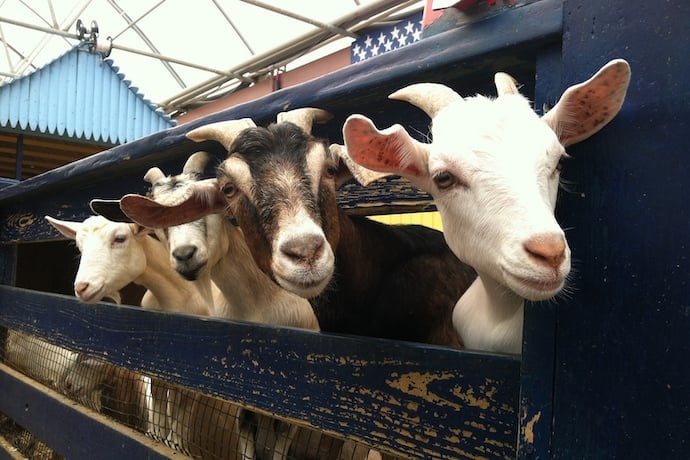For decades, “Let’s Make a Deal” was a popular TV game show. The rules were simple: there are three doors, one that hides a prize, and two that conceal “zonks” (joke prizes). Contestants either went home with the flashy sports car of their dreams, or, if they were less lucky, maybe an old toaster or a goat!
Imagine that you’re the contestant picked from the audience. To begin, the host Monty Hall asks you to randomly pick one of the three doors, each with an equal chance of being your ticket to the big prize. Let’s say you pick door #1.
Unlike you, Monty Hall knows where the car is hidden. He walks over to the two unpicked doors and opens #2 to reveal a zonk. The audience gasps! Now Monty gives you another choice: do you like the door you’ve chosen, or would you like to switch to door #3?
What should you do? Since we’ve eliminated door #2, there’s an even 50%-50% chance between the two remaining possibilities. Stay or switch? For years, contestants have agonized over a choice with no obvious right answer.
To figure out the best strategy for the Monty Hall problem, we need to learn a few basic rules of statistics.
BASIC RULES OF PROBABILITY
Let’s say you toss a coin; that’s an event. There are two possible outcomes: heads or tails. In this case, each of them are equally likely.
RULE #1: TOTAL PROBABILITY = 100%
If heads and tails are the only two possible results of a coin toss, then the probability of getting heads — P(H) — must be 50% and the probability of getting tails — P(T) — must also be 50%. If you add more possible outcomes to the mix (for example, the coin might accidentally be dropped and get lost before you can read the result) then you have to lower other probabilities so that the total sum remains 100%. For example:
P(H): probability of getting heads = 49%
P(T): probability of getting tails = 49%
P(L): probability of losing the coin = 2%
RULE #2: PROBABILITIES CAN’T BE NEGATIVE
It seems obvious — what does a -10% chance of rain even mean? — but it’s better to mention this rule explicitly. A sneaky person might try to use negative probabilities to fit more outcomes into an event. Not on our watch!
RULE #3: THE LAW OF LARGE NUMBERS
What does a “50% chance of winning” actually mean?
If you flip a coin 10,000 times, you can expect to obtain about 5000 heads and 5000 tails. In practice, this number won’t quite be perfect. Maybe you have 5024 heads (50.24%) and 4976 tails (49.76%). But if you keep flipping coins, over and over and over, these numbers will slowly morph into 50% and 50%.
In other words, probability and statistics are accurate over long periods of time. A 50-50 chance doesn’t mean you’ll get one heads followed by one tails. You might get 5 heads in a row, or 10, or even 100! A high probability doesn’t guarantee a specific outcome for a single event. They might, however, be a clue that it’s not smart to bet on something.
STAY OR SWITCH?
Going back to the Monty Hall problem, the answer is that you should always switch doors.
In this scenario, there are only three outcomes: Door #1, Door #2, and Door #3. Since total probability always sums to 100%, and all doors are equal, the chance of winning with Door #1 is 33%. (Technically, 33.33333333… We can round this up to make things easier). By extension, the chance of winning with a different door is 67%. To be super, over-the-top clear:
The chance of winning with either Door #2 or Door #3 is 67%.

When Monty opens Door #2 to reveal a zonk, the probability doesn’t rebalance itself into 50% for Door #1 and 50% for Door #3. Whys should it? Instead, take the previous statement and remove the words “either Door #2 or” from the sentence. What does it say now?
The chance of winning with Door #3 is 67%.

When Door #2 was eliminated, the cloud of probability hovering over Doors #2 and #3 “pools” into Door #3. Switching doors makes you twice as likely to win!
The idea of “pooling” becomes a little bit clearer if you imagine there are 100 doors, with 99 zonks and 1 sports car. You pick door #1, which has a very small probability of winning, and then Monty opens 98 doors to reveal 98 zonks. Does it feel “luckier” to switch to Door #100?
Don’t throw a party just yet, though! Remember, a higher probability isn’t a guarantee of winning. If you played “Let’s Make a Deal” 10,000 times with your math-savvy strategy, you could expect to win 6667 cars and 3333 zonks. But if all you have is one shot, the dice might still not fall in your favour. Sometimes the law of large numbers is just a bummer.
What the Monty Hall problem illustrates best of all is that it’s important to think twice about our first assumptions — especially in math!
Learn More
Numberphile video: Monty Hall Problem
(Short Version)
https://www.youtube.com/watch?v=4Lb-6rxZxx0
(Long Version)
https://www.youtube.com/watch?v=ugbWqWCcxrg

